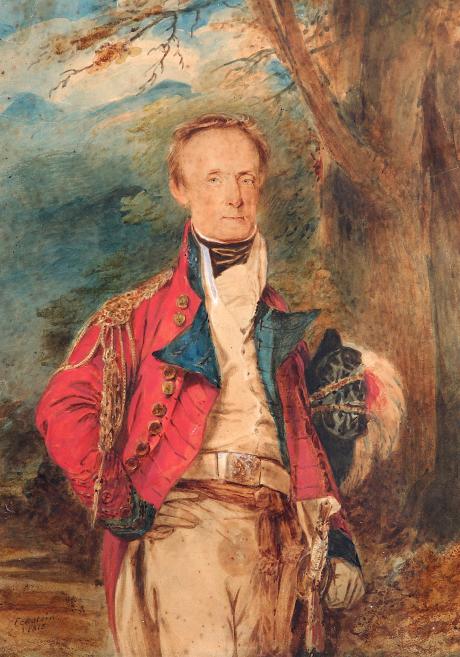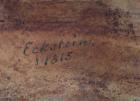"John Eckstein 1815"
Sir Charles Wale, (1763–1845), army officer, was born on 5 August 1763, the second son of Thomas Wale (1701–1796) of Shelford, Cambridgeshire, and his wife, Louisa Rudolphina, daughter of Nicholas Rahten of Lüneburg, Hanover. The family claimed descent from Walter de Wahul, recorded in Domesday Book as a landholder in Northamptonshire. Several members of the family acted as sheriff of that county. A Sir Thomas Wale was knight of the Garter in Edward III's reign, and another Thomas was killed at Agincourt in 1415. A branch of the family migrated to Ireland late in the twelfth century and founded Walestown. The branch to which Sir Charles belonged acquired Shelford in the seventeenth century. His father, Thomas Wale, an eighteenth-century squire, kept a notebook, extracts from which were printed by the Revd H. J. Wale in My Grandfather's Pocket-Book (1883).
Charles Wale was sent up to London in 1778 to learn arithmetic and fencing. In September 1779, much against his father's wish, he accepted a commission in a regiment which was then being raised by Colonel Keating, the 88th foot. He went out with it to Jamaica, but on 13 April 1780 his father purchased him ('cost £150') a lieutenancy in the 97th which went to Gibraltar with Admiral Darby's fleet in April 1781, and served throughout the latter part of the defence.
Wale obtained a company in the 12th foot on 25 June 1783, but was placed on half pay soon afterwards. On 23 May 1786 he exchanged to the 46th, and served with it in Ireland and the Channel Islands. He married in 1793 and retired on half pay, becoming adjutant of the Cambridgeshire militia on 4 December. On 1 March 1794 he was made major, and on 1 January 1798 lieutenant-colonel in the army. He returned to full pay on 6 August 1799 as captain in the 20th, and served with it in the expedition to The Helder in the autumn. On 16 January 1800 he was promoted major in the 85th, and on 9 October to lieutenant-colonel of the 67th. He joined it in Jamaica, and brought it home at the end of 1801. In 1805 he went out with it to Bengal, but returned to England and exchanged to the 66th on 16 June 1808.
Wale did not serve long with the 66th. He had been made colonel on 25 April 1808, and in March 1809 he was appointed a brigadier-general in the West Indies. He commanded the reserve in the expedition under Sir George Beckwith, which took Guadeloupe in February 1810, and was wounded in the action of 3 February. On 4 June 1811 he was promoted major-general, and on 21 February 1812 was appointed governor of Martinique, and remained so until it was restored to France in 1815. He was made KCB on 2 January 1815, promoted lieutenant-general on 19 July 1821, and general on 28 June 1838, and made colonel of the 33rd foot on 25 February 1831. In politics he was 'of the high Conservative party' (GM). He was Colonel of the Duke of Wellington's Regiment (West Riding ) from 1831 - 1845.
Wale was three times married: first, in 1793, to Louisa, daughter of the Revd Castel Sherrard of Huntington; second, in 1803, to Isabella, daughter of the Revd Thomas Johnson of Stockton-on-Tees; third, in 1815, to Henrietta, daughter of the Revd Thomas Brent of Croscombe, Somerset. Wale died at Shelford, Cambridgeshire, on 19 March 1845. He was survived by his third wife, seven sons, and five daughters.
Wale's eighth son, Frederick Wale (1822–1858), army officer in the East India Company, entered the East India Company's service in 1840, and was posted to the 48th Bengal native infantry on 9 January 1841; lieutenant 23 February 1842, captain 1 October 1852. He was appointed brigade major at Peshawar on 19 August 1853, and was serving there when his regiment mutinied at Lucknow in May 1857. He took command of the 1st Sikh irregular cavalry (known as ‘Wale's horse’), and served in the relief of Lucknow, and in the siege and capture of it in March 1858. His unit formed part of the 2nd cavalry brigade, and the brigadier reported that Wale 'showed on all occasions great zeal in command of his regiment, and on 21 March led it most successfully in pursuit of the enemy till he was shot' (London Gazette, 21 May 1858). Lord Roberts wrote that he was 'a gallant officer' (Roberts, 227). He had married Adelaide, daughter of Edward Prest of York; they had two daughters.
E. M. Lloyd, DNB.
Johann or John Eckstein (1735-1817), was a German-born sculptor, engraver and painter who worked briefly in London before establishing himself in his homeland and then in America. He is not to be confused with his son, also known as John, a painter who worked in England and the West Indies. He was born at Poppenreuth near Nuremberg on 25 November 1735, the son of Conrad Eckstein, a woodcarver and cabinet-maker, and was the elder brother of George Paul Eckstein. He studied under Preissler, at the Academy of Arts at Nuremberg before moving to England.
Something is known of Eckstein's early career in London from the fact that he signed the relief on the monument to Roger Townsend in Westminster Abbey, made in the workshop of Benjamin and Thomas Carter and set up in 1761. He did not, however, design the relief himself, but worked from a terracotta model by Luc-François Breton. In April 1762 the Society of Arts awarded him a premium for a Portland stone relief, which he exhibited the next year at the Society of Artists. Another premium followed in 1764.
In 1765 Eckstein accepted an invitation from Frederick the Great to work at the Prussian court, where he became the king's principal sculptor, executing numerous works at Potsdam and Sans Souci. In 1769 another invitation took him to the court of the Grand Duke of Mecklenberg at Ludwigslust, who sent him a mission to England the next year. In London he met with an enthusiastic reception and exhibited wax portraits at the Royal Academy.[1] After a year he returned to the Grand Ducal court, where he worked on the sculpture of the Hofkirche and made wax reliefs, including a surviving portrait of Friedrich Franz I. After four years at Ludwigslust he moved back to Berlin at the invitation of the king.In 1775–6 he modelled for the porcelain factory there, and exhibited at the Academy. In 1786 he took the death mask of Frederick, from which he made the heads for wax busts. He continued to receive royal patronage from Frederick's successor, Frederick William, and may have carved metopes from models by Johann Gottfried Schadow for the Brandenburg Gate in Berlin in 1792.
In 1793 Eckstein wrote to George Washington from Potsdam, requesting money to pay for his passage to the United States, as he intended to settle in Philadelphia. It is not known if Washington responded, but Eckstein was in America by November of the same year, when he and his son Frederick advertised an exhibition of paintings, sculpture, and wax models at their house at 323 Market Street, Philadelphia. Eckstein became a founder member of the Philadelphia Academy and between 1810 and 1814 also showed work at the Society of Artists, where his exhibits included an equestrian figure of Washington, apparently intended for a monument to be erected in the city.
In 1805 he published the first part of The American Drawing Magazine, or, A Complete System of Drawing, described in a subtitle as "adapted to the use of all persons who would become accomplished in this branch of education, by which they may be instructed without the aid of a teacher, and also become acquainted with the first rudiments of painting, sculpture, and architecture". It is not known whether any of the other eleven planned parts was ever issued.
He did not find great success in the United States. According to an obituary "he had to lament that his professional labours did not meet with that encouragement in a new country, which is so liberally bestowed upon genius in Europe; and, like many of his brother artists, he had to struggle with adversity during many of the latter years of his life." Thomas Sully described him as "a thorough-going drudge in the arts. He could do you a picture in still life — history — landscape — portrait — he could model — cut a head in marble — anything you please". One of his last works was a marble bust of Emanuel Swedenborg commissioned by William Schlatter. In January 1817 Eckstein sailed for Havana, drawn by the prospect of being employed to finish a large monument that had been left incomplete. He died in Havana on 27 June 1817, aged 81.
Eckstein was the father of another John Eckstein, a painter who exhibited at the Royal Academy in London between 1787 and 1802. In 1803 he accompanied Samuel Hood to the "Diamond Rock" near Martinique. He then went to Barbados where he painted portraits of officers stationed on the island, and seems to have died in the West Indies in about 1838.



